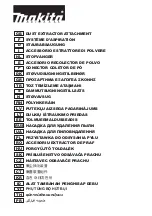
LIT1024
©
2022 EXAIR Corporation 6/6/22
USING TURBOBLAST SAFETY AIR GUNS
A good practice when using the TurboBlast Safety Air Gun is to install a suitably sized ball valve at the other end of the
airline supplying the Safety Air Gun. This allows for de-energizing the line during long periods of no use or if debris in the
compressed air supply prevents the valve on the TurboBlast Safety Air Gun from closing all the way. Model 900346 (1
NPT
Ball Valve) is available from EXAIR to serve this purpose.
The TurboBlast Safety Air Gun is designed to be operated between 50 PSIG (3.4 BAR, 345 kPa) and 120 PSIG (8.3
BAR, 827 kPa). The pilot valve will not open under 50 PSIG and the gun will not operate. Exceeding 120 PSIG can
cause damage to the Safety Air Gun and create a hazard to the operator. If less airflow is needed use the optional Gate
Valve to reduce airflow to the nozzle.
Be sure to have a firm grip on the hand-held TurboBlast Safety Air Gun before you compress the trigger. The blast of air
should be aimed at the target surface. The pilot valve shuts off automatically if the TurboBlast Safety Air Gun is dropped.
All Safety Air Guns and TurboBlast Safety Air Guns meet or exceed OSHA requirements by using EXAIR engineered air
nozzles and jets. All are safe to be supplied with higher pressure compressed air and meet the OSHA standard CFR
1910.242(b) for dead-ended pressures. The sound level of all TurboBlast Air Guns exceeds 90 dBA. OSHA allows 3 hours of
exposure per day without hearing protection for models 1914, 1914SS, 1924 and 1924SS; 2 hours for 1915, 1915SS, 1925
and 1925SS; 1 hour for models 1916 and 1926 and 1/2 hour for models 1917, 1927, 1918 and 1928. Detailed information on
the specific Air Nozzle can be found in the EXAIR Catalog and at www.exair.com.
The optional gate valve can be added to any TurboBlast configuration. The gate valve allows immediate adjustability of the
airflow during operation. Turn the collar on the gate valve clockwise to increase airflow and counter-clockwise to reduce
airflow. Gate Valves are included on models 1924, 1924SS, 1925, 1925SS, 1926, 1927 and 1928.
SAFE OPERATING PRACTICES
The following is a safety checklist to encourage proper use of the TurboBlast Safety Air Guns.
1. Inspect all of the components used in the compressed air system to make sure that all connections (fittings) are tightened
properly.
2. Inspect the TurboBlast Safety Air Gun to make sure there is nothing attached to the end that might become a flying
projectile.
3. Always wear safety glasses with side shields when working nearby the blowoff operation.
4. Always consider the direction you blow the compressed air. Make sure the debris flies in a safe direction away from
yourself and others.
5. Always depressurize a compressed air line before attaching a TurboBlast Safety Air Gun. Repressurize the line once
connected.
6. Never use compressed air to clean your clothing or dislodge particles. These particles can be embedded in your skin. High-
pressure air can also penetrate the skin and reach the bloodstream which can produce a serious or fatal injury.
7. Never engage in horseplay or point a TurboBlast Safety Air Gun at someone.
TROUBLESHOOTING & MAINTENANCE
If there is a reduction in flow or force from the TurboBlast Safety Air Gun, check the pressure by installing a gauge at the
compressed air inlet of the Air Gun. Large pressure drops are possible due to undersized lines, restrictive fittings, and clogged
filter elements.
For replacement or repair of filter and regulator parts, contact EPUTEC at +49 8191 91 51 19 0 or [email protected].
CLEANING
If contaminants have clogged the TurboBlast Safety Air Gun, inspect the unit by removing the air nozzle and air hose
connected to the air inlet. Position the air nozzle extension into a soft jaw vise. Use a wrench to unscrew the air nozzle from
the end of the extension. Inspect each part for dirt contamination and a possible oil film in the area of the slotted nozzle.
Clean each part and reassemble.





















